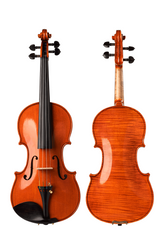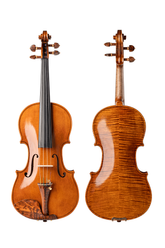F-holes of the violin
There are two sound holes on the top plate of the violin. Their shape is very similar to the letter f, so they are also called f-holes. Because there are two, they are sometimes called ff holes. The seemingly simple f-holes contain rich content.
Table of Contents
- The evolution of the F-hole of the violin
- Formed by continuous evolution
- Formed according to the aesthetic point
- Formed according to the acoustic performance
- The structure of the F-hole of a violin
- The Importance of the F-Hole of a Violin
- Process of F-hole
- The Influence of Violin F-Hole on Violin Pronunciation
- The production school can be seen from the F-hole of the violin
The evolution of the F-hole of the violin
Andre Amati (1520-1581) was the founder of the Cremona school and also the founder of the Amati family. Influenced by the Renaissance, he absorbed the essence of classical art in modeling, and according to the aesthetic standards of people at that time, Integrating architectural aesthetics into it, the design is considered to be the earliest shape of the violin in the modern sense.
The violin sound hole he designed has two sound holes whose body parts are almost parallel, the upper and lower round holes are large, and the wing part is relatively narrow. The overall appearance is smooth, with no edges and corners, in the shape of an f.
In the beginning, the sound holes of stringed instruments were not f-shaped, but this evolved with the development of the times, and finally formed the f-hole shape we see now.
The reason for the formation of the F-shaped sound hole has not been very clear. At present, there are mainly three viewpoints, which are formed by continuous evolution, formed according to the aesthetic point of view, and formed according to the acoustic performance.
Formed by continuous evolution
In ancient Egypt 2,000 years ago, there was a musical instrument called a Lyre, which was shaped like a violin and had a sound hole shaped like a C. During the Renaissance, there was an instrument called the Lira that had a complete evolution of its soundhole, culminating in an f-shaped soundhole that is closest to the modern violin.

Formed according to the aesthetic point
For a long time, the shape of the violin conforms to the typical baroque style, so many people think that the shape of the violin is more about the artistic effect than the acoustic effect.
Alvin Thomas King wrote the article "Cremonese System for Positioning the F-Holes" in 2004, in which he mentioned that the F-hole of the violin is made based on the golden section theory in aesthetics, which is consistent with the violin made by Andre Amati.
Formed according to the acoustic performance
The F hole of the violin is not simply a decoration, but it is also an integral part of the sound system. According to the research results published in Proceedings of the Royal Society A by Nicholas Makris and others from the Department of Mechanical Engineering of the Massachusetts Institute of Technology, this special shape does have a decisive impact on the dynamics of musical instruments.

1: The intensity of sound radiation produced by the resonance of the violin cavity is only related to the change of airflow. The longer the body of the F-type violin, the greater the airflow through it.
2: The F-shaped sound hole has little damage to the fiber of the violin top plate.
3: The circulation of air in the sound hole of the instrument is mainly concentrated on its surface rather than the center. The F-type sound hole greatly reduces its ineffective area.
The structure of the F-hole of a violin

There is a round hole called a circle at the upper and lower ends of the sound hole. Between the two round holes is a long hole made of arcs, which is the shaft. The small pieces of the top plate between the hole and the beads are the wing. The shapes of the circle, shaft and wing are all parts for the luthier to display their artistic talents. There are V-shaped notches on both sides of the middle part of the F-hole, which is also the installation position of the bridge.
The Importance of the F-Hole of a Violin
The sound of the violin ultimately needs to be transmitted through the F-hole. If the violin does not have F-holes, its sound will be dull and it is difficult to make a beautiful sound.
The F-hole can reflect the artistic style and characteristics of the luthier. From the F hole, we can roughly see the key points of a violin's model, style, and handwork.
Process of F-hole
For F-hole, the most important thing is Elegant Subtlety, because the shape can be imitated, but Elegant Subtlety is the combination of each person's talent and skill, and each person's knife handling gestures and strength are also different, which is very difficult to imitate. The workmanship of the F hole can be observed from the following 7 aspects.
1: Whether the two F-holes are symmetrical and balanced. (Master Guarneri del Gesu's work will be more casual)
2: The size and position of the F-hole should be correct. Each violin shape has a corresponding size and position.
3: The shape of the circle should be round or a variation of the round.
4: Whether the tangent extension line of the wing is on the center line of the violin body.
5: The shaft of the F-hole must be smooth.
6: The cutting surface of the F-hole can be cut straight or obliquely. The straight-cut F-hole is more stable, but it will affect the appearance; the obliquely-cut F-hole has a better appearance and better vibration, but it is easy to be damaged.
7: The inclination of the F-hole is not only related to the tone but also closely related to the production style. For example, most of the Gagliano family in Italy are relatively vertical.
The Influence of Violin F-Hole on Violin Pronunciation
The F-hole of the violin is an important part of the sound system of the violin, and different shapes of the F-hole will affect the sound of the violin.
If the F hole is large, it means that the cutting area of wood fibers is large, which will reduce the hardness of the middle of the top plate, which is easy to vibrate the template and increase the volume of the violin, but the sound will be rough.
If the F-hole is small, the cutting area of wood fibers is small, and the hardness in the middle of the top plate will be relatively strong so that the volume will be smaller, but the tone will be softer.
The production school can be seen from the F-hole of the violin
Cremona School
1. Andrea Amati is the first member of the Amati family of the Cremona school. The shape of the sound hole of the violin he made has been described before. He not only designed the modern violin but also changed the sound hole Design, letting the F-shaped sound hole become mainstream.
2. Nicolo Amati is the greatest violin maker in the Amati family and the founder of the Cremona School. He inherited Andrea Amati's F-shaped hole design and improved it. The two ends of the f-hole body he designed are very thin, and the size of the wings is relatively wide. The lines look very smooth and graceful.
3. Antonio Stradivari is one of the greatest violin makers in the history of violin production. His early works were deeply influenced by his teacher Nicolo Amati and later formed his style. The designed sound hole is almost parallel to the body from the side, and the curve of the sound hole is very harmonious with the curve and radian of the body. The tangent line of the lower circle is the line connecting the end points of the inlays on both sides of the violin top plate.
4. Giuseppe Guarneri del Gesu is a great violin maker alongside Antonio Stradivari. The sound hole he designed is relatively full and much longer than the sound holes of other Cremona luthiers, and there are corners at the turning points of the upper and lower round holes.
Brescia School
1. Gasparo Bertolotti da Salo is the first well-known master violin maker of the Brescia school in Italy. The sound hole he designed is not very symmetrical, and the F shape is relatively straight and slender.
2. Giovanni Paolo Maggini is the most outstanding disciple of Gasparo Bertolotti da Salo. The sound hole he designed is very delicately carved, with small convex angles and small wings, and the lower round hole is smaller than the upper round hole.
Every structure of the violin has its meaning. For each of us violin lovers, it is not only a musical instrument but also our companion.





